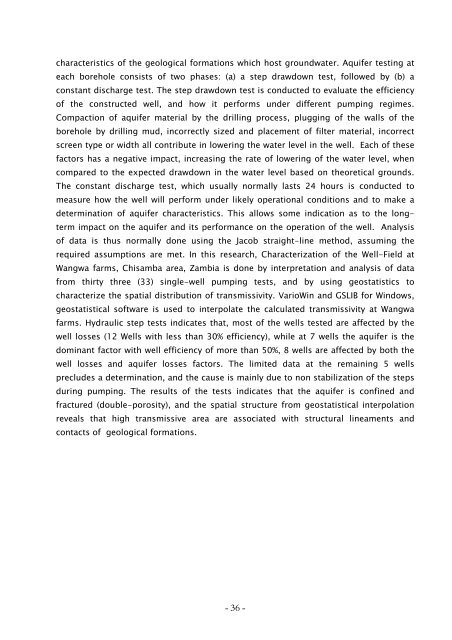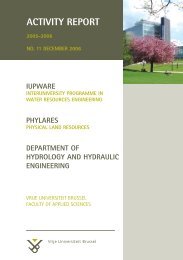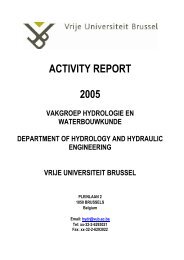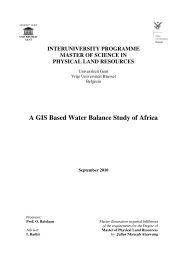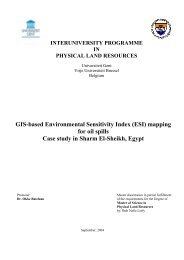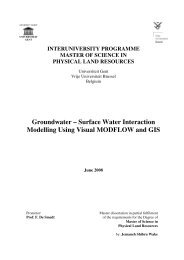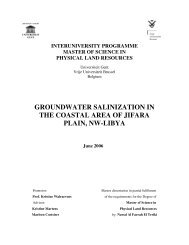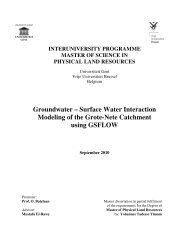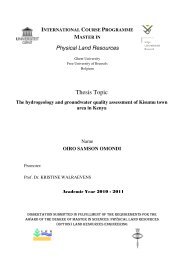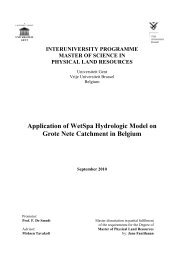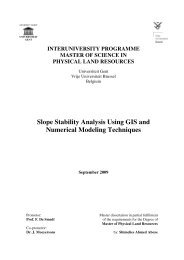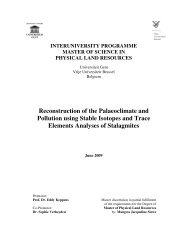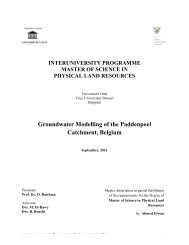C O N T E N T S - Physical Land Resources - Vrije Universiteit Brussel
C O N T E N T S - Physical Land Resources - Vrije Universiteit Brussel
C O N T E N T S - Physical Land Resources - Vrije Universiteit Brussel
Create successful ePaper yourself
Turn your PDF publications into a flip-book with our unique Google optimized e-Paper software.
characteristics of the geological formations which host groundwater. Aquifer testing ateach borehole consists of two phases: (a) a step drawdown test, followed by (b) aconstant discharge test. The step drawdown test is conducted to evaluate the efficiencyof the constructed well, and how it performs under different pumping regimes.Compaction of aquifer material by the drilling process, plugging of the walls of theborehole by drilling mud, incorrectly sized and placement of filter material, incorrectscreen type or width all contribute in lowering the water level in the well. Each of thesefactors has a negative impact, increasing the rate of lowering of the water level, whencompared to the expected drawdown in the water level based on theoretical grounds.The constant discharge test, which usually normally lasts 24 hours is conducted tomeasure how the well will perform under likely operational conditions and to make adetermination of aquifer characteristics. This allows some indication as to the longtermimpact on the aquifer and its performance on the operation of the well. Analysisof data is thus normally done using the Jacob straight-line method, assuming therequired assumptions are met. In this research, Characterization of the Well-Field atWangwa farms, Chisamba area, Zambia is done by interpretation and analysis of datafrom thirty three (33) single-well pumping tests, and by using geostatistics tocharacterize the spatial distribution of transmissivity. VarioWin and GSLIB for Windows,geostatistical software is used to interpolate the calculated transmissivity at Wangwafarms. Hydraulic step tests indicates that, most of the wells tested are affected by thewell losses (12 Wells with less than 30% efficiency), while at 7 wells the aquifer is thedominant factor with well efficiency of more than 50%, 8 wells are affected by both thewell losses and aquifer losses factors. The limited data at the remaining 5 wellsprecludes a determination, and the cause is mainly due to non stabilization of the stepsduring pumping. The results of the tests indicates that the aquifer is confined andfractured (double-porosity), and the spatial structure from geostatistical interpolationreveals that high transmissive area are associated with structural lineaments andcontacts of geological formations.- 36 -


